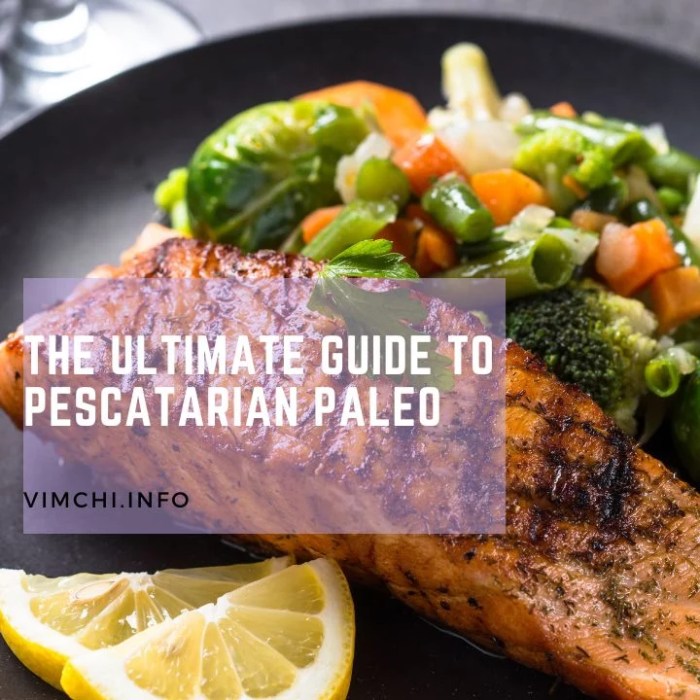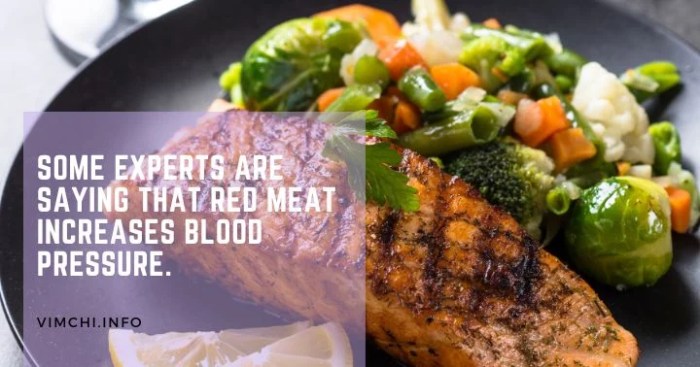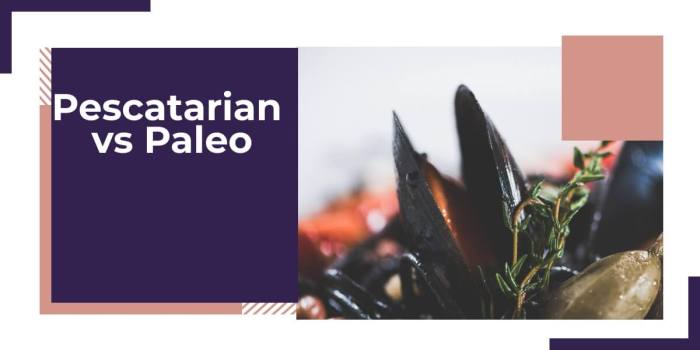Embark on a culinary adventure with the paleo pescatarian diet, a unique fusion of ancestral principles and marine sustenance. Discover the secrets of this intriguing dietary approach, where the wisdom of our ancestors meets the bounty of the sea.
Immerse yourself in the world of paleo pescatarianism, where ancient dietary wisdom intertwines with the health-promoting benefits of seafood. This engaging guide delves into the principles, potential health advantages, challenges, and practical implementation of this captivating dietary paradigm.
Paleo Pescatarian Diet
The paleo pescatarian diet combines elements of the paleo diet and the pescatarian diet. It emphasizes whole, unprocessed foods while including fish and seafood. This diet aims to provide the benefits of both dietary approaches, promoting overall health and well-being.
Principles and Guidelines
The paleo pescatarian diet follows the principles of the paleo diet, which focuses on consuming foods that were available to humans during the Paleolithic era. This includes lean meats, fruits, vegetables, nuts, and seeds. The pescatarian aspect of the diet adds fish and seafood to the menu, providing a source of omega-3 fatty acids and other essential nutrients.
Foods Included and Excluded
Foods Included:
For those looking to embrace a healthier lifestyle, a veggie only diet can be an excellent option. This type of diet emphasizes the consumption of plant-based foods, such as fruits, vegetables, and whole grains, while excluding animal products. By eliminating meat, dairy, and eggs, individuals can reduce their intake of saturated fats and cholesterol, potentially improving overall health.
Lean meats
Chicken, turkey, fish, seafood
Fruits
Berries, apples, bananas, oranges
Vegetables
Leafy greens, broccoli, carrots, onions
Nuts and seeds
Almonds, walnuts, chia seeds, flaxseeds
Healthy fats
Olive oil, avocado, coconut oil Foods Excluded:
Grains
Wheat, rice, cornDairy products
-
Legumes
Beans, lentils, peas
- Processed foods
- Sugary drinks
- Refined carbohydrates
Health Benefits of the Paleo Pescatarian Diet

The paleo pescatarian diet, which combines elements of the paleo and pescatarian diets, offers a range of potential health benefits. These benefits stem from the diet’s emphasis on whole, unprocessed foods, including fish, vegetables, fruits, nuts, and seeds.
Reduced Inflammation
The paleo pescatarian diet is rich in anti-inflammatory foods, such as fish, leafy greens, and berries. These foods contain antioxidants and other compounds that help to reduce inflammation throughout the body. Chronic inflammation is linked to a variety of health problems, including heart disease, cancer, and arthritis.
By reducing inflammation, the paleo pescatarian diet may help to protect against these conditions.
Improved Heart Health
The paleo pescatarian diet is also beneficial for heart health. The diet’s emphasis on fish, fruits, and vegetables provides essential nutrients for heart health, such as omega-3 fatty acids, fiber, and antioxidants. Omega-3 fatty acids help to lower blood pressure and reduce the risk of heart disease.
Fiber helps to lower cholesterol levels and improve blood sugar control. Antioxidants help to protect against damage to the heart and blood vessels.
Weight Management
The paleo pescatarian diet is a weight-loss-friendly diet. The diet’s focus on whole, unprocessed foods helps to promote satiety and reduce cravings. Additionally, the diet’s high protein content helps to boost metabolism and burn calories.
If you’re considering adopting a veggie only diet , it’s essential to do your research and ensure you’re getting all the necessary nutrients. While a plant-based diet can offer numerous health benefits, it’s crucial to approach it with a balanced and informed perspective.
Challenges and Considerations
While the paleo pescatarian diet offers numerous benefits, it also comes with certain challenges and considerations.
One potential challenge is nutrient deficiencies, as this diet eliminates grains, legumes, and dairy products. This can lead to a lack of essential nutrients like calcium, iron, and fiber.
Supplementation and Substitutes
To overcome this challenge, supplementation or finding suitable substitutes for restricted foods is crucial. Calcium-fortified plant-based milk, leafy green vegetables, and fatty fish can provide adequate calcium intake. Iron-rich foods like red meat or organ meats can be consumed in moderation, or iron supplements can be taken.
For fiber, incorporating non-starchy vegetables, fruits, and nuts into the diet can help meet daily fiber requirements.
Sample Meal Plan and Recipes

The paleo pescatarian diet emphasizes whole, unprocessed foods, with a focus on seafood, vegetables, fruits, and nuts. Here’s a sample meal plan to help you get started: Breakfast:
- Scrambled eggs with smoked salmon and avocado
- Paleo granola with berries and almond milk
Lunch:
- Grilled salmon salad with mixed greens, roasted vegetables, and a lemon-tahini dressing
- Tuna salad with celery, onion, and a mayonnaise-free dressing
Dinner:
- Seafood stir-fry with brown rice
- Roasted chicken with roasted vegetables
Snacks:
- Apple slices with almond butter
- Vegetable sticks with hummus
Recipes
Grilled Salmon with Roasted VegetablesIngredients:
- 1 pound salmon fillet, skin-on
- 1 tablespoon olive oil
- 1 teaspoon lemon juice
- 1/2 teaspoon salt
- 1/4 teaspoon black pepper
- 1 cup broccoli florets
- 1 cup cauliflower florets
- 1 cup carrots, peeled and cut into sticks
Instructions:
- Preheat oven to 400°F (200°C).
- Line a baking sheet with parchment paper.
- In a large bowl, combine the salmon, olive oil, lemon juice, salt, and pepper. Toss to coat.
- In a separate bowl, combine the broccoli, cauliflower, and carrots. Toss with olive oil, salt, and pepper.
- Spread the vegetables on the prepared baking sheet and roast for 15-20 minutes, or until tender.
- Add the salmon to the baking sheet and roast for an additional 10-12 minutes, or until cooked through.
Seafood Stir-FryIngredients:
- 1 pound shrimp, peeled and deveined
- 1 pound scallops, shucked and cleaned
- 1/2 cup chopped onion
- 1/2 cup chopped green bell pepper
- 1/2 cup chopped red bell pepper
- 1 cup broccoli florets
- 1 cup cauliflower florets
- 1/2 cup carrots, peeled and cut into sticks
- 1/4 cup soy sauce
- 1/4 cup water
- 1 tablespoon cornstarch
- 1 tablespoon olive oil
Instructions:
- In a small bowl, whisk together the soy sauce, water, and cornstarch.
- Heat the olive oil in a large skillet over medium-high heat.
- Add the shrimp and scallops and cook until browned on both sides.
- Add the onion, green bell pepper, red bell pepper, broccoli, cauliflower, and carrots. Cook until the vegetables are tender.
- Stir in the soy sauce mixture and cook until thickened.
- Serve over brown rice.
Comparison to Other Diets
The paleo pescatarian diet shares similarities with other popular diets, such as the Mediterranean diet and the vegetarian diet. However, it also has some key differences.
Comparison to the Mediterranean Diet
Both the paleo pescatarian diet and the Mediterranean diet emphasize the consumption of whole, unprocessed foods, such as fruits, vegetables, and lean protein. They also both limit the intake of processed foods, refined carbohydrates, and sugary drinks. However, the paleo pescatarian diet is more restrictive than the Mediterranean diet in terms of the types of foods that are allowed.
For example, the paleo pescatarian diet does not allow the consumption of grains, legumes, or dairy products.
Comparison to the Vegetarian Diet, Paleo pescatarian
The paleo pescatarian diet and the vegetarian diet both exclude meat from the diet. However, the paleo pescatarian diet allows the consumption of fish and seafood, while the vegetarian diet does not. This makes the paleo pescatarian diet a more flexible option for people who want to reduce their meat consumption but still want to eat animal products.
Benefits and Limitations of Different Diets
The paleo pescatarian diet, the Mediterranean diet, and the vegetarian diet all have their own unique benefits and limitations. The paleo pescatarian diet is a good option for people who want to lose weight, improve their blood sugar control, and reduce their risk of chronic diseases.
However, it can be a restrictive diet that is difficult to follow long-term. The Mediterranean diet is a well-rounded diet that is associated with a number of health benefits, including reduced risk of heart disease, stroke, and cancer. However, it is not as restrictive as the paleo pescatarian diet, so it may not be as effective for weight loss.
The vegetarian diet is a good option for people who want to reduce their risk of heart disease and cancer. However, it can be difficult to get enough protein and other nutrients on a vegetarian diet.
Conclusive Thoughts

As we bid farewell to our exploration of the paleo pescatarian diet, remember that dietary choices are deeply personal. Whether you embrace this ancestral-aquatic approach or seek alternative paths to well-being, may your journey be guided by knowledge, mindful choices, and a profound appreciation for the nourishment that sustains us.
General Inquiries
What are the key principles of the paleo pescatarian diet?
The paleo pescatarian diet emphasizes whole, unprocessed foods, prioritizing seafood, fruits, vegetables, nuts, and seeds while excluding grains, legumes, and dairy.
What are some potential health benefits associated with the paleo pescatarian diet?
Studies suggest that this diet may reduce inflammation, improve heart health, aid in weight management, and promote overall well-being.
Are there any challenges to following a paleo pescatarian diet?
Potential challenges include nutrient deficiencies, social restrictions, and the availability of compliant foods. However, supplementation and creative meal planning can help overcome these obstacles.